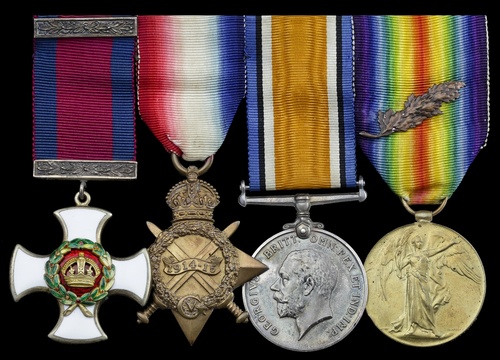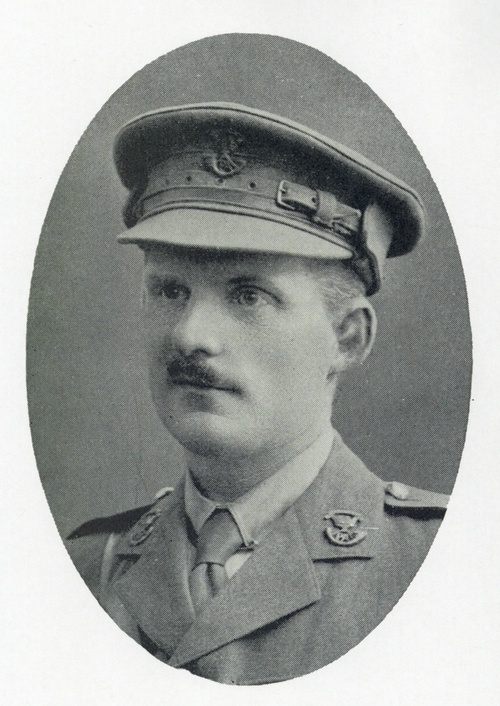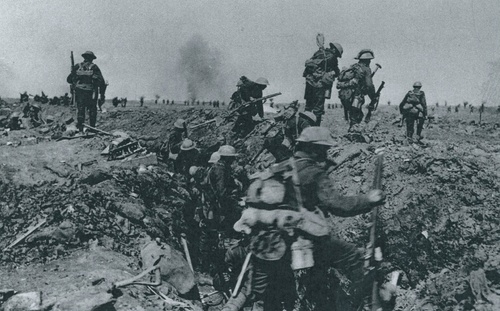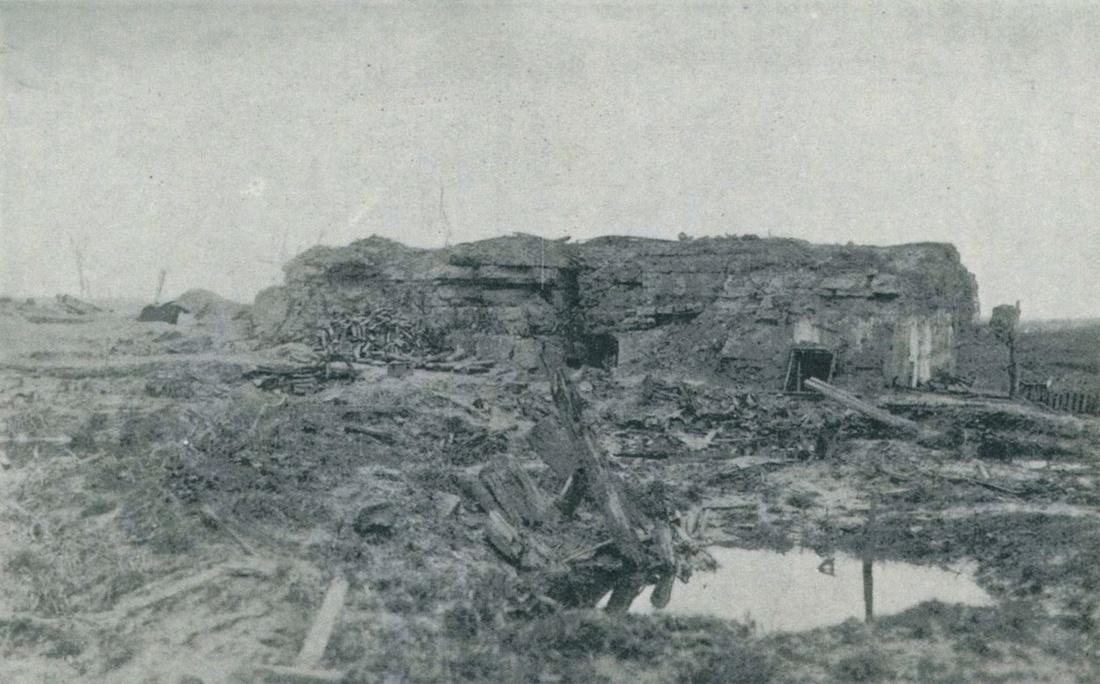Auction: 19002 - Orders, Decorations and Medals
Lot: 225
Nobody who served in the 1914-18 War with the 7th Battalion of the Regiment could possibly remember it without possibly remembering Colonel Troyte-Bullock. From its formation in 1914 until he was severely wounded in 1918 he led and inspired it almost continuously.
His unfailing devotion to duty could not but leave a deep impression on all who saw it and those who knew him well realized that his courage and serenity sprang from his strong religious convictions.
More by his own example than by precept he demanded of his officers a high standard of behaviour in everything.
Night after night in the trenches one would meet him, long stick in hand, visiting every post in the front line - however deep the mud or heavy the shelling; during a battle he would reach the captured position almost before the attacking companies had begun to consolidate it and pass along the line with a calm and almost casual word of encouragement for everyone.'
His obituary in The Light Bob Gazette, April 1958, refers.
An outstanding Great War Battalion C.O.'s 'Battle of Guillemont 1916' D.S.O. group of four awarded to Colonel C. J. Troyte-Bullock, 7th Battalion, Somerset Light Infantry
An inspiring and courageous leader he led his men through some of the worst conditions endured during the Great War
Distinguished Service Order, G.V.R., silver-gilt and enamel; 1914-15 Star (Lt. Col. C. J. Troyte-Bullock. Som: L. I.); British War and Victory Medals, with M.I.D. oak leaves (Lt. Col. C. J. Troyte-Bullock.), mounted as worn, first with top riband bar adapted for mounting and some slight green enamel chipping to wreath, otherwise good very fine (4)
Exhibited:
Five Star Ranks - A Celebration of the Officers, Spink, April 2019.
D.S.O. London Gazette 14 November 1916:
'For conspicuous gallantry in action. He led his battalion, which was in reserve, with great skill, and by his prompt reinforcement of the attacking line materially helped to beat off a counter-attack. Though wounded in the leg, he remained in command till the position was secured.'
Cecil John Troyte-Bullock was born at Shaftesbury, Dorset on 17 May 1869 and was commissioned 2nd Lieutenant in the 4th (Militia) Battalion, Somerset Light Infantry in March 1889. Having transferred to the 1st Battalion in October 1891, he was Adjutant of the 2nd Battalion, Royal Jersey Light Infantry, July 1900-November 1905. Returning to the 2nd Battalion, Somerset Light Infantry, he served in North China during 1912 and was on leave from India pending retirement in April 1914. At the outbreak of the Great War, in the rank of Major, Troyte-Bullock took command of the 7th Battalion. Marched from Aldershot to Woking on 21 September at strength of 1,200, it joined Major-General H. R. Davies's 61st Infantry Brigade.
Opening shots - 1915
In February 1915, the Battalion marched from Woking to Witley Camp, Godalming and then onto Salisbury Plain in March. Inspected by the King on 24 June, it was clear it would soon be off to war. Landing at Boulogne at 11 p.m. on 24 July, the Battalion proceeded by train to Wizernes the next day, marching to Hazebrouck, Noote Boom and finally Le Rossignol by 29 July. Resting, Troyte-Bullock had the men '...carrying on our training and listening to the guns in the distance and wondering when our turn would come to make their close acquaintance.'
They would not have to wait long, for they were ordered to the trenches at Armentieres on 10 August, and welcomed by the enemy, who called out 'Hullo! You Somerset cuckoos.' They suffered their first casualty, Private C. Stephens, 'A' Company, who was shot by a sniper on sentry duty during their first week. More were to follow on 12 September, having relieved the 12th Battalion, King's (Liverpool) Regiment, east of Cordonnerie Farm. At 5.20 a.m., the earth under them shook as a large mine was detonated by the enemy, followed by shells raining down and machine-gun fire. Seven were killed outright, with a further 17 wounded. On 24 September, further casualties were suffered in an attack which lacked artillery support.
The remainder of 1915 ground on in typical attritional style for the 7th Battalion, suffering on average one casualty a day. Billeted in Fleurbaix, the Battalion's Christmas celebrations were interrupted by shelling on the village, which required 'C' Company to take to the field for an hour or so '...until the Germans ceased their unfriendly attentions.' Nonetheless it was noted that '...our Xmas dinner was a great success.'
Out of the frying pan, into the fire - 1916
Transferred to the Ypres salient in early 1916, Troyte-Bulloch and his men would serve in trenches full of water, the men up to their knees whilst resting. On 11 April the enemy made a large and determined attack, forcing the Battalion back over the Canal Bank they controlled.
Rested and rotated, they marched back to the Ypres-Zonnebeke road to replace the 2nd Battalion, Coldstream Guards on 19 May, being attacked with losses at 12.45 a.m. on 21 May when three German parties advanced on the positions, with hand-to-hand fighting required to end the engagement. It cost two officers wounded, one other rank killed and 22 wounded, whilst '...three dead Germans hung on the wire in front of the trenches.'
The Battalion would be afforded little rest into June 1916, for it was constantly called to 'stand to' on account of the unrelenting German attacks upon the Canadian Corps to the north.
Troyte-Bullock would earn a well-deserved 'mention' for the above operations (London Gazette 15 June 1916, refers).
Guillemont - D.S.O. and first wound
His finest hour would come on 3 September 1916, when the Battalion was charged with taking the village of Guillemont. The Regimental History states:
'Some 1,500 yards south-east of the "Devil's Wood" there lay a ruined shell-blasted village, which again and again had been captured and lost; this was Guillemont. The enemy's positions in and about the village were of a very powerful nature. On the surface his trenches were deep and well made, whilst below ground the place was literally honeycombed with deep dug-outs, huge cellars, and subterranean passages in which whole battalions could be accommodated.'
Some days prior, Troyte-Bullock and his men had advanced to Serre, the point at which the 1st Battalion made their fateful attack on 1 July and the corpses of their comrades littered the trenches which the 7th Battalion were to occupy before Guillemont. Having reconnoitred the attack with Major Lyon and his four Company Commanders on 29 August, the whole Battalion breakfasted in the Carnoy Craters at 7.30 a.m. on 3 September in preparation for the attack with the 59th Division. Zero hour was 10.30 a.m. and the Somersets made their advance at noon. Moving in four lines of Companies in artillery formation, they suffered a hostile 5.9 barrage after the Montauban-Guillemont road, but the men did not let down their gallant C.O., instead they '...went through it as if they were on Salisbury Plain.' Having made contact with the 6th Battalion, Oxfordshire & Buckinghamshire Light Infantry they halted. At this moment German artillery focussed on the positions and poured in shrapnel which was '...with marvellous precision bursting over the West Countrymen.' Moving down the hill and out of range and the second objective having been captured by the 10th Battalion, Rifle Brigade and 11th Battalion, King's Royal Rifle Corps, the 7th Battalion was ordered onto the third objective, the Sunken Road moving towards Guillemont Cemetery.
Having called in a Divisional barrage, the Somersets made their attack, capturing one officer and 46 other ranks in quick succession. With the 5th Division being held up behind, thus leaving Troyte-Bullock and his men with an exposed flank, they were instructed at 7.45 p.m. to attack Leuze Wood. The C.O. commented:
'The Companies were now all well dug in and full of beans.'
Troyte-Bullock was himself in the process of visiting and inspiring his Company Commanders at which point he was struck in the leg by a machine-gun bullet, he nonetheless 'carried on' in fine style. Final acclaim must go to the men of 'B' Company who dug in around the Cemetery. In the words of Troyte-Bullock himself:
'If 'B' Company had not done their job in the way they did the left flank of the 20th Division would have been turned and most of the ground gained would have been lost.'
Having stuck to his command, Troyte-Bullock was finally admitted to hospital once the operations were complete. It had cost them one officer killed and nine wounded, with a further 140 other ranks killed or wounded.
Awarded the D.S.O. a little over a month later, Troyte-Bullock re-joined his unit on 5 November. A light interlude occurred on 12 December, when Sergeant Dawson found himself swallowed to the armpits in the sinking mud of No Man's Land. Having been found by a party of five Germans, he had assumed his war was over. Instead the Germans proceeded to help him from the mud, make themselves his prisoners and lead him back to British lines, for he was lost. The officers were '...somewhat surprised when the sentry shouted down to say that there were five Huns coming down the stairs!' Troyte-Bullock added a second 'mention' to his accolades (London Gazette 4 January 1917, refers).
Further campaigning
Appointed Acting Brigadier from January - March and during June 1917, Troyte-Bullock had welcomed Lord Cavan to inspect his troops. Cavan brought unwelcome news of a return to the Sailly-Saillisel sector - full of mud and filth. Their tour from 8 February around Morval was considered '...quite the worst tour in the line, abominable conditions in this part of the line it is perhaps sufficient to say that the communication trenches were only useable when the ice bore.'
The 1st March would see 2nd Lieutenant Brown win the M.C. and Sergeant Towler the D.C.M., while the remaining months would witness further attacks in the area. By August the Battalion had been withdrawn to 'fatten up for the next battle', but were unfortunate to lose 27 men when a shell landed amongst 'B' Company on 14 August, wiping out almost an entire Platoon. By now the unit numbered just 470 'effectives'.
Au Bon Gite - Langemarck
It was on 16 August that Troye-Bullock and his men were detailed to attack the fearsome Au Bon Gite pill-box, which had held up successive attacks in the previous months. They were to be in the first line of attack with the 7th Battalion, King's Own Yorkshire Light Infantry to their left. The attack would be with other units of the 61st Brigade, together with a triple-layer artillery barrage, a 48 machine-gun barrage and low-flying aeroplanes to strafe the Germans and keep them in their shell holes. With Zero set for 4.45 a.m., the first wave crossed a flooded stream, thick with mud and covered by an enemy machine-gun nest. Before this, the Germans had built their defences around Steenbeek, setting up lights, machine-gun posts and a barrage. When the British barrage came down, the advance began. Casualties started to mount quickly, but Au Bon Gite fell to 'B' Company. The day was not won however, as a continuation of the attack was required and they pushed onto the pill-boxes around Reitres Farm.
Eventually, however, some individual brilliance led to these falling too, with Troye-Bullock in the shell-holes some 500 yards from Langemarck Church. Shortly before 6 a.m., the enemy shells began to fall around the Headquarters, so Troyte-Bullock made an advance himself. Firstly he advanced to a concrete building about 200 yards from the positions, but found this on poor ground, thus moving on to another building on the north west side of the Langemarck-Pilkem road, about 450 yards east of the bridges over the Steenbeek. He then personally went forward to join the men of 'D' Company. He found them '...consolidating their position amongst ruined houses and battered tree trunks. He then went to the southern-most cross-roads of the village, where stood a large concreted building, apparently the old cemetery chapel. From the top of this building he could get a good view as far as the crest of the ridge beyond the second objective.'
Reinforcements in the form of a battalion of the Welch Regiment arrived later that day, bringing up ammunition and much-needed water for the troops. Further counter-attacks followed the next day, but the 7th Battalion consolidated its position. Lord Cavan returned to congratulate Troyte-Bullock and his men.
The attack cost four officers and 37 other ranks killed, with nine officers and 139 other ranks wounded. By the end of the Ypres operations they had suffered five officers and 102 other ranks killed, with 14 officers and 335 other ranks wounded.
The remainder of the summer proved a quiet enough affair, with exceptionally good game on offer for the crack shot - indeed '...partridges abounded, many were shot and sent back to Battalion Headquarters for the C.O.'s dinner.'
Troyte-Bullock received his third 'mention' (London Gazette 18 December 1917, refers).
St. Quentin - severe wound
By the time of the offensives into Picardy in early 1918, the 7th Battalion found itself entrenching on the corner of the Crozat Canal and the Somme, near St. Simon. Working under thick fog on 22 March, two Companies were on the Canal bank, whilst the other two were with Battalion H.Q., behind some wooded marshland. Having been promised they would be supported by troops on the right flank towards Jussy, Troyte-Bullock later commented:
'As a matter of fact the only troops we ever did get in touch with in that direction were the Huns on the morning of the 23rd.'
German cavalry patrols spotted the position at dawn and with the sun rising through thick fog, the Battalion blew the bridges at St. Simon. Ordered to move Battalion H.Q., with his two Companies, Troyte-Bullock started for Annois along the railway. Bad news came from Jussy, however, as the bridges failed to fall there, allowing a German advance headlong at Troyte-Bullock and his men, straight along the railway lines. The Regimental History continues:
'The end came quickly. Rifle and machine-gun fire had suddenly become intense and casualties were heavy. The Acting Adjutant (Lieut. S. G. Barry) fell dead, Lieutenant-Colonel Troyte-Bullock was severely wounded.'
The remaining men made a spirited withdrawal under galling fire. Troyte-Bullock was returned to England on 27 March 1918. He saw no further action in France and was retired on 16 February 1924. But Troyte-Bullock returned to the fold and '...aged about 70, was one of the first to volunteer for the Corscombe Home Guard, but midway through the war he was retired because of his age.' He died on 7 February 1958 and is buried in the East Coker Churchyard, Somerset. A fitting extract from his Light Bob Gazette obituary (April 1958) states:
'A practical proof of his leadership and influence was seen in an annual dinner which must now be almost unique. 38 years after the Battalion was disbanded and in spite of distance, ill-health and deaths, a dozen or more of his old officers could still be found to greet him at Taunton last July. And this was no formal gathering but could truly be described as a meeting of "we few, we happy few, we band of brothers."'
Subject to 20% VAT on Buyer’s Premium. For more information please view Terms and Conditions for Buyers.
Sold for
£2,400
Starting price
£1400











